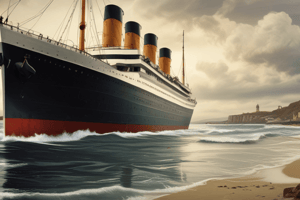Podcast
Questions and Answers
All passengers on the Titanic were treated equally regardless of their class.
All passengers on the Titanic were treated equally regardless of their class.
True (A)
The Titanic carried a total of 2,224 passengers and crew members.
The Titanic carried a total of 2,224 passengers and crew members.
True (A)
First-class passengers had to endure cramped and uncomfortable conditions on the Titanic.
First-class passengers had to endure cramped and uncomfortable conditions on the Titanic.
False (B)
What was the consequence of the Titanic hitting the iceberg?
What was the consequence of the Titanic hitting the iceberg?
Which role did RMS Titanic's chief steward, Rochlan Valandré, play during the tragedy?
Which role did RMS Titanic's chief steward, Rochlan Valandré, play during the tragedy?
What was a significant factor contributing to the fatal outcome of the Titanic's collision with the iceberg?
What was a significant factor contributing to the fatal outcome of the Titanic's collision with the iceberg?
Describe the role of Ruth Becker during the Titanic's sinking.
Describe the role of Ruth Becker during the Titanic's sinking.
Why did Jack Thayer's father choose not to board a lifeboat during the Titanic's sinking?
Why did Jack Thayer's father choose not to board a lifeboat during the Titanic's sinking?
What was one of the most significant flaws contributing to the Titanic's tragic end?
What was one of the most significant flaws contributing to the Titanic's tragic end?
How did Jack Thayer manage to get into a lifeboat during the chaos of the Titanic's sinking?
How did Jack Thayer manage to get into a lifeboat during the chaos of the Titanic's sinking?
What significant changes in maritime law and safety regulations were brought about by the aftermath of the Titanic's sinking?
What significant changes in maritime law and safety regulations were brought about by the aftermath of the Titanic's sinking?
Flashcards are hidden until you start studying
Study Notes
The Sinking of the Titanic
On a fateful April evening in 1912, history bore witness to one of the most tragic and memorable maritime disasters: the sinking of the Titanic. This unspeakable event, marked by heroism and heartache, continues to captivate our imaginations and shape how we view the ocean's unpredictable nature.
Events Leading to the Sinking
The Titanic, famously known as "unsinkable," was a testament to human engineering and the pinnacle of maritime achievement at the time. However, it was the Titanic's collision with an iceberg on the night of April 14, 1912, that irrevocably altered the course of history.
The Titanic was traveling at a record-breaking speed of 22.5 knots when it encountered the iceberg, resulting in a devastating breach in the ship's hull. The collision punctured the watertight compartments, causing an unprecedented flood of water into the ship's lower decks.
History of the Titanic
The Titanic, a British passenger liner, was launched in 1911 and set sail on its maiden voyage from Southampton, England, to New York City on April 10, 1912. The 882-foot long, 92,329-ton vessel was the largest and most luxurious ship of its time, heralded for her opulent interiors, amenities, and cutting-edge design.
The Titanic was built by Harland and Wolff in Belfast, Northern Ireland, and was designed by Thomas Andrews, a renowned naval architect. Andrews, sadly, would not live to see the Titanic reach its final resting place on the North Atlantic floor.
Passengers and Crew
The Titanic carried a diverse and international community of passengers, from wealthy aristocrats and industrialists to humble laborers who traveled for a variety of reasons. At the time of its departure, the Titanic held 2,224 passengers and crew members.
First-class passengers traveled in opulent surroundings, enjoying lavish accommodations and sumptuous meals, while third-class passengers endured more cramped and spartan conditions. Despite the varying classes, all passengers were considered equally valuable and were given equal access to lifeboats during the evacuation.
Conclusion
The sinking of the Titanic is a tragic reminder of the unpredictable nature of the sea, an event that continues to captivate our imagination and shape our understanding of human resilience and the devastating consequences of human error. The lessons learned from the Titanic's tragic fate have been instrumental in shaping the modern standards of maritime regulation and safety, ensuring that future generations of seafarers may travel the world's oceans with greater peace of mind.
Studying That Suits You
Use AI to generate personalized quizzes and flashcards to suit your learning preferences.




